
People, cars causes problems for Yosemite
YOSEMITE VALLEY, Calif. — When automobiles were first allowed to enter in 1913, Yosemite National Park quickly became one of the most popular tourist destinations in the country.
Today, almost a century later, the automobile has become one of the leading causes of adverse conditions in the park.
“Increase in park attendance is great, but it also means general park deterioration, mostly because of cars. Overall, we all need to do our job to keep this park beautiful,” stated Kari Cobb, Yosemite park ranger and spokesperson.
National Park Service statistics indicate that, in 1985, 2,938,462 visitors were recorded. Last year’s numbers were 3,557,961, and there appears to be a general increase in visitor attendance since the current economic recession began.
“The 2009 trends appear to look somewhat like the 1998 trends, which was a popular year at the park,” said Cobb.
In 1998, 3,792,754 people visited the park, with the most popular months being in the summer from May through August.
Ninety percent of individuals who visit the park actually only stay in Yosemite Valley, which is where the stores, restaurants and hotels are located, so the area is constantly populated with campers, buses and cars.
| At right, bicycles are rented to enjoy scenery and to be environmentally helpful. Below, signs are used because some plants have been damaged. Next, cars often must wait to park. Last, because visitors often walk on sensitive soil, black oak seedlings have difficulty growing (Photos by Elena Chiriboga). | 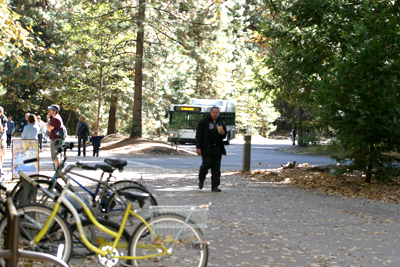 |
There are 1,387 lodging units found in Yosemite National Park, most of them found around the valley and must be reserved months in advance in order to obtain a room, so naturally most visitors spend the day driving through the park because of the lack of lodging facilities.
During the past 30 years, the number of individuals and families staying at the park has changed direction. Eighty percent of those who visit Yosemite National Park end up staying for just a day basis. Many of these arrive in groups on tour buses.
“We’ve seen a great increase in California visitors because of the increase in gas prices. These are people who might have normally done a road trip across the country, but because gas is expensive they are staying closer to home,” said Cobb.
One of the main duties of the rangers at Yosemite National Park is to help manage flow of visitors to preserve the park from damage but the ratio of visitors to rangers makes the job increasingly difficult.
As Cobb stated, “to curb the destruction by vehicles we put up signs to say no parking is allowed in certain areas.”
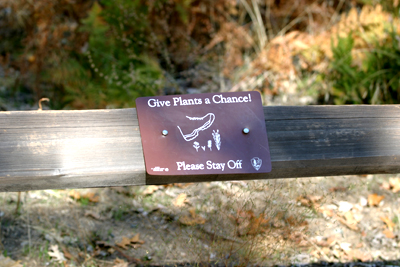 One of the most popular activities at Yosemite is camping, and, although the rangers at the park encourage individuals to have the best experience they can while immersed in the beautiful landscape, they also ask that visitors follow park regulations.
One of the most popular activities at Yosemite is camping, and, although the rangers at the park encourage individuals to have the best experience they can while immersed in the beautiful landscape, they also ask that visitors follow park regulations.
A long history of camper use of the meadows and traffic found on unpaved roads caused the Valley to be filled with dust by the end of each summer during the mid 1900s.
By the 1970s, Yosemite needed a plan to help manage the increase in tourism and the adverse and apparent effects it was causing to the park.
The Yosemite General Management was created and was a significant step towards the preservation for the natural habitat of the park, but it also had some unfavorable effects.
It took the Yosemite General Management plan 10 years to create most of what is used by park visitors today. One-way road traffic patterns were established, cars were eliminated from the east end of the Valley, shuttle bus transportation came into effect and tram tours began to be given in the Mariposa Grove area of the park.
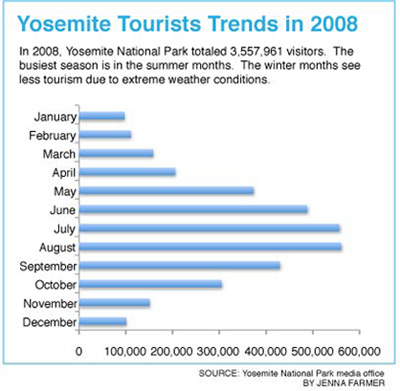 With Yosemite General Management focused upon the needs of visitors and establishing these services, individuals found the park more accessible and the frequent use of vehicles in the park proved to be the most pressing issue for the park service.
With Yosemite General Management focused upon the needs of visitors and establishing these services, individuals found the park more accessible and the frequent use of vehicles in the park proved to be the most pressing issue for the park service.
“I’ve been to this park almost 10 times in the past 15 years, and I can really notice that little by little the park is suffering because of vehicle destruction.
“There’s not a whole lot of parking, so people just park wherever sometimes and don’t notice what they’re doing to the nature in the park,” said Los-Angeles native, Mauricio Lopez-Rivera.
High levels of park attendance affiliated with vehicular traffic have caused the Yosemite National Park administration to wonder how it can still allow visitors to enjoy the exuberance of the park, but, at the same time, preserve the habitat of the more popular areas of the park for future visitors.
Park rangers have noted that some parts of the riverbanks near campsites have deteriorated because of careless visitors.
Automobiles in the park primarily cause traffic congestion, mostly in the summer months because there is insufficient parking, which is something the park administration cannot remedy because of funding issues. During summer months, visitors often find themselves in congested traffic, waiting around until a parking spot opens.
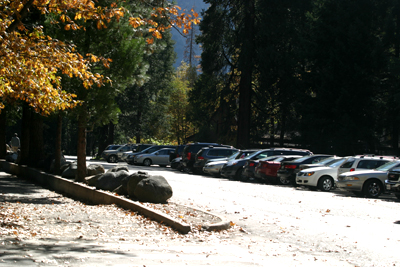 Allowing automobiles in the park results in the need for more parking lots and wider roads; it also bring about noise, air pollution and destruction of the Yosemite flora, which includes flowering species, tree species and meadows.
Allowing automobiles in the park results in the need for more parking lots and wider roads; it also bring about noise, air pollution and destruction of the Yosemite flora, which includes flowering species, tree species and meadows.
The park has numerous signs distributed throughout the boardwalks that ask visitors to keep off the plants. On a walk through a trail around the valley a visitor might see more than one dozen signs prompting visitors to take part in preserving the black oak woodland tree.
After years of continued visitor walking and trampling the soil where the California black oak woodland grows, seedlings are finding it hard to grow because the soil has become very sensitive. These trees have an important role in Yosemite because they are home to bears, squirrels, birds and deer and are a source of food for the native people who eat the acorns from the tree.
A visitor walking through the valley will most likely see plastic tubes standing upright from the ground. These tubes are an effort made by those at Yosemite to preserve the seedlings and contain them in a roped off area. Visitors are asked to stay on appropriate trails in order to prevent more damage from occurring.
The meadows are one of Yosemite’s well-known attractions but are also suffering from visitors trampling in them. The soil is sensitive and unfortunately becomes ruined with all the walking and some small animal’s nests are permanently damaged.
Because of the damage the meadows have endured, extreme care has been needed to restore the meadows and efforts have been made by the National Park Foundation and The Yosemite Fund. Volunteer groups actively work in this area by putting up fencing that conserves the habitat.
Individuals who come to Yosemite for a quiet haven are also frequently disrupted by noise pollution that competes with the natural noises found in the park.
With the 30 percent increase of automobile use in the past decade, car emissions have caused Yosemite Valley to be hidden amongst thick smog. There is a visible haze caused by urban developments and agriculture waste.
The Trade and Environmentalist website, started by Dr. James R. Lee from the School of International Service of the American University, contains analysis of cases dealing with conflicting issues in the environment. According to the environmentalists at TED, the “smog is so thick that Yosemite Valley could not be seen from the air.”
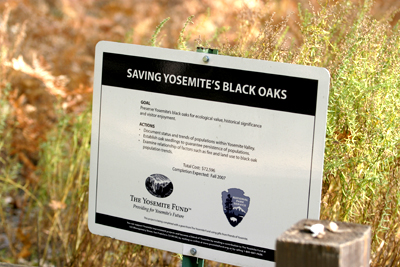 To add to the harmful effects of vehicle emission, automobiles also pose a threat to the wildlife in Yosemite. According to the National Parks Service website, nps.gov, 24 bears have been injured this year from speeding cars, and 20 of those have been killed.
To add to the harmful effects of vehicle emission, automobiles also pose a threat to the wildlife in Yosemite. According to the National Parks Service website, nps.gov, 24 bears have been injured this year from speeding cars, and 20 of those have been killed.
“I have seen those ‘speeding kills’ bears signs, but I am not sure how useful they are. I really don’t know the number of animals that have been killed by cars, but it’s a shame when they are because this is their home,” said California native and camper Craig Duman.
Yosemite National Park, because of all the visitors it attracts, is also alluring other types of development that nature lovers look down upon.
New housing projects have come into effect and commercial businesses are constantly being developed. One of the newest attractions has been the Chukchansi Casino; the casino is 30 miles from the Yosemite Valley and boasts the slogan “Now, Yosemite has a night life.”
Despite all the preservation efforts the park attempts, it appears that damage to the park is inevitable with the amount of tourism it attracts unless visitors truly realize that preserving the wilderness is the idea that should prevail.
While enjoyment is what the National Park Service hopes its visitors encounter, one must be aware that future generations deserve to experience the park as past on.

Comments are Closed